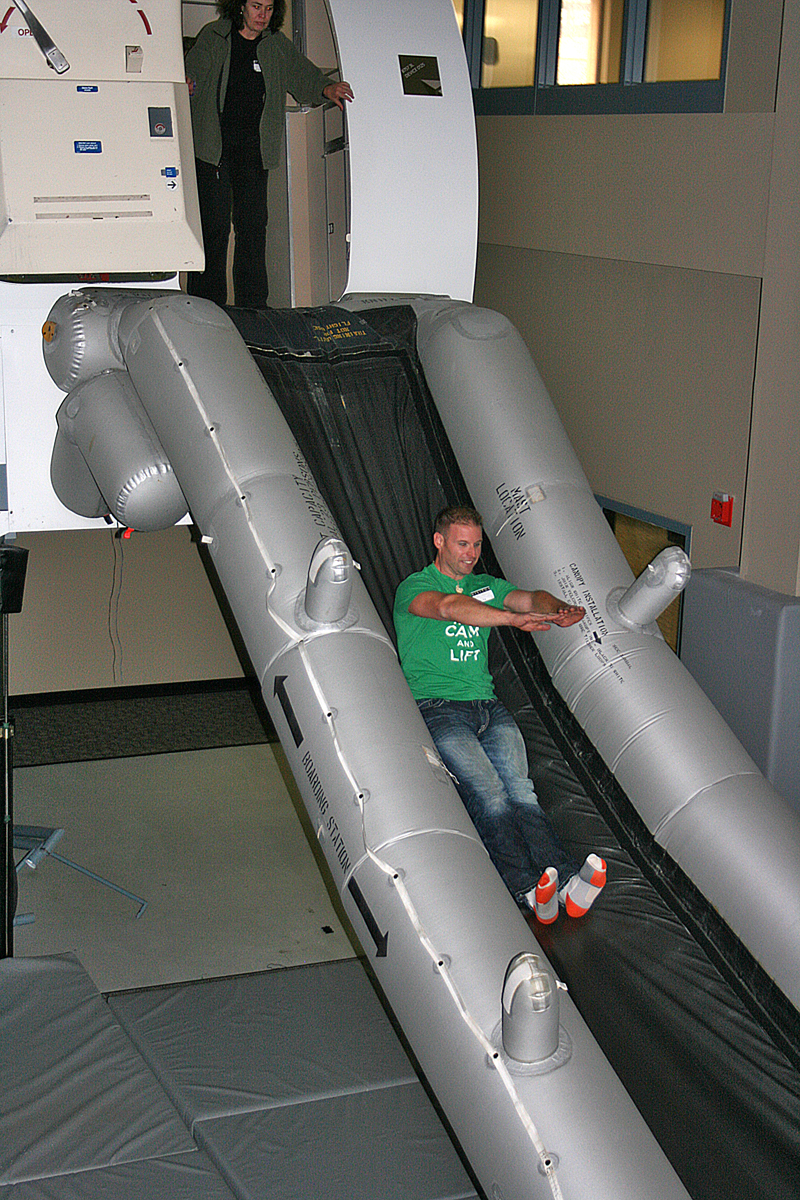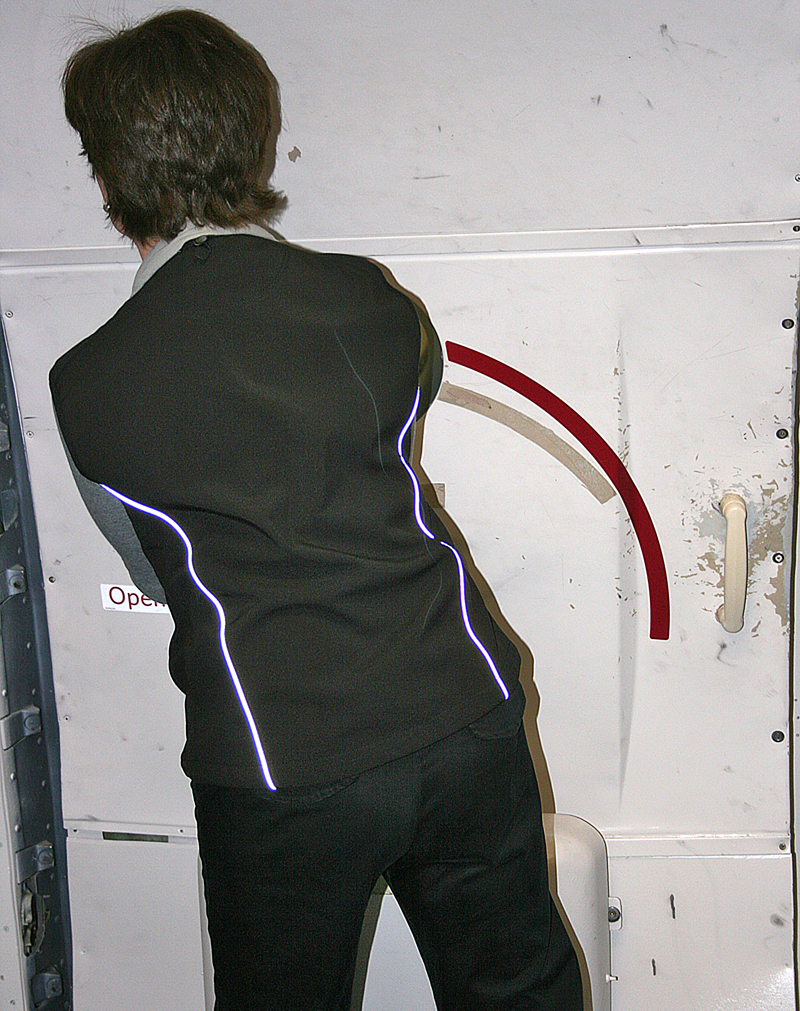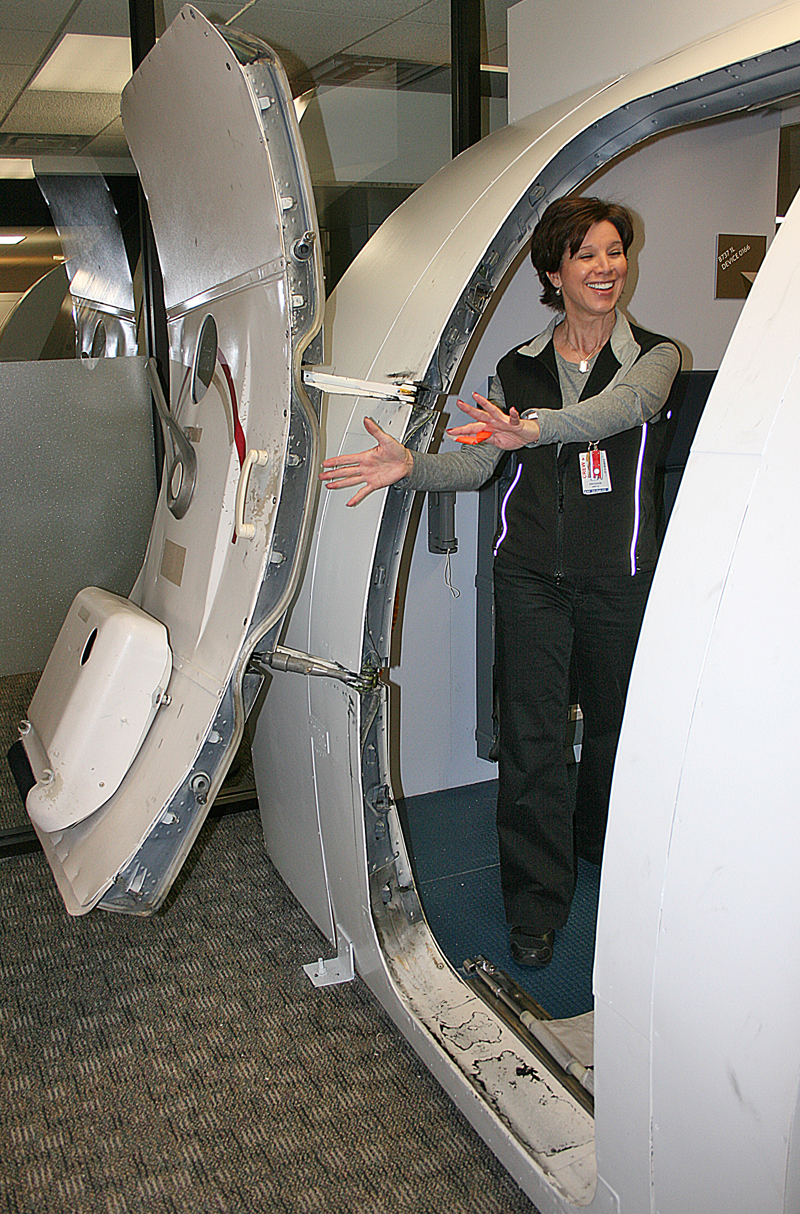The probability of you being involved in a crash or accident while you are a passenger seated aboard an airplane is so remote that you will likely never have either of those experiences — but if you do, you may have to use an inflatable evacuation slide.
6 Steps on How to Safely Use an Evacuation Slide In the Event of an Emergency
At first glance, evacuation slides look like they could be fun to use — but in the event of an actual emergency, they can actually be daunting to some people. For one thing, many passengers do not realize how high up off the ground they actually are when they are aboard an airplane; and the height may trigger symptoms of acrophobia in some people. Next time you board an airplane, take a look down at the crack between the jet bridge and the aircraft itself, and you will notice the height off of the ground — especially when boarding a larger airplane.
That height factor — as well as the nature of the emergency itself — can contribute to temporary paralysis of some passengers who may suddenly and irrationally refuse to exit the airplane down an inflatable evacuation slide. This scenario can result in blocking other passengers who are trying to exit the aircraft; and thus delay the entire evacuation process — during which every precious second counts and could be the difference between life and death.
Another factor to consider is that inflatable evacuation slides must be manufactured with a number of safety features as mandated by the Federal Aviation Administration of the United States — meaning that sliding down an inflatable evacuation slide may not be so easy for some people. Even under a controlled testing environment, some users of inflatable evacuation slides may suffer injuries, which range from as minor as what are known as “slide burns” to major injuries which can actually include breaking a limb.
If you find yourself in an emergency situation through which you are ordered by members of the flight crew to use an inflatable evacuation slide to exit the airplane, remember the following tips to better ensure that you will survive the emergency and successfully leave the airplane — and the situation.
1. Ensure That You Are Not Wearing Clothing Which Can Inhibit Evacuation

Even with the proper clothing, getting stuck on an inflatable evacuation slide is easier than you might think — so before you leave your home or other origination point prior to travel, wear simple clothing manufactured out of materials such as cotton.
If you wear attire which is made with materials such as latex, leather or rubber, your evacuation process could potentially be slowed down due to increased friction.
Also, wear sensible shoes. Flip flops, sandals and other loosely fitting footwear could inhibit your egress from the aircraft; and pointy high heels could potentially poke a hole in the otherwise strong materials of which the inflatable evacuation slide is comprised. You are better off wearing socks than escaping with bare feet — again, to reduce the friction component of escaping down a slide.
Avoid wearing pantyhose and other clothing comprised of artificial materials, as they can potentially melt onto the skin in the heat of a fire aboard an airplane.
Finally, avoid wearing articles of clothing which are superfluous and could potentially cause a problem. For example, neckties could catch onto something during the escape and potentially cause strangulation. Rather, pack such items in your belongings and wear them after the conclusion of the flight.
2. NEVER Evacuate From an Airplane With Your Belongings
Every second which you consume to retrieve any belongings of yours is one fewer second to escape from the emergency situation — not only for yourself; but also for passengers behind you.
Additional information is included later in this article.
3. Head Towards the Nearest Available Exit

Notice the use of the word available, as the nearest exit to where you are located aboard the airplane may not be usable.
During the evacuation of an airplane, a member of the flight crew may notice a fire outside of one of the exit doors — or some other situation which is not conducive to a safe and expedient escape. You will clearly know not to use the exit, as a member of the flight crew will block the exit, cross his or her arms above his or her head, and repeatedly shout as loudly as possible “Bad exit!!! Bad exit!!!”
4. Have an Alternate Plan

Whenever you board an airplane, note as many of the exits near you as possible. Some exits may be in the form of doors; while others may be in the form of windows. Count how many seats you are from the two nearest exits — preferably one on each side of the airplane, in case conditions on one side are substantially better than those on the other side — so that if the cabin fills with smoke in the unlikely event of an emergency, you still have an idea of where to go.
Even in a cabin filled with smoke, you may not be able to see all of the emergency lights which should be illuminated along the floor. You might see the first few white lights near where you are located; but the red lights near the exit may not be visible through the smoke.
5. Once at the Exit: JUMP!!!
This may seem counterintuitive; but in order to properly use an inflatable evacuation slide, a member of the flight crew will order you to jump as far out of the aircraft as possible. This is to help ensure as speedy an evacuation as possible; and one of the reasons is to gain as much speed as possible to ensure that you safely reach the bottom of the slide.

When you jump, ensure that your hands and feet are as far out in front of you as possible to streamline your body down the evacuation slide — but do not lay down. Once your body hits the slide, emulate a reclined sitting position with your hands and feet out in front of you. Alternately, you can also cross your arms as close to your chest as possible.
Placing your limbs out on the sides or near the posterior of your body can not only hinder the speed of your escape; but they also risk being injured — or worse, broken. Also, many injuries occur when people hit the ground and sprain an ankle or break a leg because they descended down the slide out of control. Remaining in control of your escape down the evacuation slide is critical in ensuring that you escape as quickly as possible without getting injured.
Some women and older passengers have been known to suddenly hesitate at the exit at the top of the evacuation slide; and other people attempt to first sit down before sliding. Both of these actions will slow down the evacuation process, as each slide is manufactured to handle 70 passengers per minute.
If every single person who evacuates from the airplane jumped instead of hesitated, the duration of the evacuation process could take as little as half the time — again, saving precious seconds and be the difference between life and death.
6. Get Out of the Way — Immediately
Once you have reached the ground at the bottom end of the evacuation slide, get out of the way as soon as possible. Either step to the side of the slide to assist other people; or get as far away from the slide as possible while remaining in the area to be available for emergency personnel on the ground.
People who do not leave the bottom end of the evacuation slide quickly enough can potentially cause a collision of people who slide down after them. That mass of humanity piling up can weight down the evacuation slide to the point where its angle becomes significantly steeper — and injuries could be sustained as a result. Remember — the evacuation slide is inflatable.
Evacuation slides are typically equipped with targets and light-emitting diode lights built into them, which gives evacuating passengers points for which to aim when jumping on and off of the slide.
The Safety of Inflatable Evacuation Slides
Typically comprised of nylon which is highly resistant to tearing, inflatable evacuation slides are coated with urethane which is sprayed with gray aluminized paint in order to protect it in case of a fire by reflecting heat for at least 90 seconds during its use — although some slides can be constructed of more durable materials, depending on when, where and by whom they were manufactured. It must flex precisely under a variety of weights to ensure that people slide down as quickly and as safely as possible.
Inflatable evacuation slides are tested regularly — such as every three years — and once they are deployed, they are then removed and inspected; tested again; and then packed, and installed back onto the aircraft. They are required to deploy within six seconds in temperatures ranging between –65 degrees Fahrenheit and 160 degrees Fahrenheit; and they must be capable of unfurling in winds up to 25 knots or 28.7 miles per hour. They must be light and compact enough to fit inside an aircraft door, below the door sill, or emergency exit window.

When you hear the announcement of a “cross-check” over the public address system after the aircraft is parked at the gate, that is the signal for one member of the flight crew to check the action of another of disarming the doors to prevent inflatable evacuation slides from inadvertently deploying. Inhibiting the egress of passengers from the airplane is only one problem which can result.
Why You Should Never Evacuate From an Airplane With Your Belongings
“The pre-flight briefing should drop the seat belt how-to and include a clear explanation of liability coverage in the case of an accident. Ok, maybe that sounds dull — but I suspect many people grab belongings because they relate it to ‘lost luggage’ in typical ops, where getting remuneration is exceedingly difficult. ‘Leave your stuff behind; we’ll replace it all. We can’t replace your life.’”
This comment written by Ed I — who is a reader of The Gate — was in response to this article pertaining to 5 reasons never to evacuate an airplane with your belongings…
..but although leaving belongings aboard an airplane during an evacuation may seem like simple common sense, why do passengers grab their belongings anyway?
Several articles which I have read indicate that passengers may simply be used to retrieving their belongings when a plane lands — which seems to be common, no matter from what part of the world in which you are based — and people are automatically concerned about getting their luggage without thinking about the consequences.
“There are lots of psychologists with opinions but no controlled studies of the phenomenon. You can’t recreate it in a lab setting because you can’t put people in a life-or-death situation,” according to this article written by Richard Westcott for BBC News which quotes Ashley Nunes, who is an aviation expert. “Studies show that the likelihood of a cabin being consumed by fire increases significantly after 90 seconds, but those evacuation tests don’t account for people trying to take their luggage with them.”
Members of the flight crew train rigorously for weeks at a time to prepare for what no one hopes is an eventual occurrence; and that training includes instructing harried passengers — some of who may be in shock.
“The initial advice was to sit tight, which is good,” according to this article written by Mark Tran of The Guardian, which quotes James Thompson, who is a fellow of the British Psychological Society. “But then it gets confusing because you’re told to get the hell out. So the initial message is to freeze and the next is to flee. However, once you are told to flee, you should just go and not bother with the £100 you are leaving behind.”
Could passengers also be too worried about recouping the value of their belongings from the airlines, as inferred by Ed I?
Passengers seem to rarely listen to the safety announcements from either members of the flight crew or from a safety video prior to departure of the flight; and amongst the reasons could be complacency, boredom, disinterest — or all of those reasons combined. Airlines have attempted to ensure that their safety videos are more interesting and entertaining — but if they even watch the video, are passengers remembering what an actor did versus the actual message which the safety video is required to impart? Is the safety message coming across effectively — or have the safety videos failed in their primary purpose in general?
Perhaps the perceived adversarial relationship between airlines and their customers may have a significant psychological role associated with this phenomenon, as passengers may very well automatically assume that airlines seem to do everything they can to “enhance” the overall experience to the point of it being as miserable, stressful and frustrating as possible in terms of cost, comfort and inconvenience. Why should they listen to — or trust — the words from an entity which does not seem to care about them, anyway?!?
“The problem has vexed regulators because it involves human behavior, which is notoriously hard to fix. Among the solutions that have been suggested: beefed-up preflight instructions, additional training for the flight crew and overhead bins that can be automatically locked in an emergency”, according to this article written by Alan Levin and Mary Schlangenstein for Bloomberg. “A safety study the NTSB compiled in 2000 found that 36 flight attendants interviewed after evacuations reported that passengers carrying bags were the biggest impediment. Almost half of passengers involved in evacuations who had carry-on bags, 208 out of 419 interviewed, admitted to trying to take items with them, the study said.”
Even the Federal Aviation Administration of the United States has tried to alleviate this significant problem — but with little success: “If an emergency evacuation is necessary, leave your carry-on items on the plane. Retrieving personal items may impede the safe evacuation of passengers.”
Summary
Did you notice that the gray aluminized inflatable evacuation slide which is shown in a photograph in this article doubles as the large inflatable raft which is shown in this article pertaining to what to do to survive an airplane water landing?

Always heed the instructions of members of the flight crew, as they train for weeks to ensure that you remain safe during an emergency — and be as knowledgeable as possible about the information in which your escape will be as safe and as efficient as possible:
- Wear the proper clothing.
- Read the safety information card, which is located in the seat pocket in front of you.
- Pay attention to the safety information imparted either by members of the flight crew or from a safety video.
- Know where your potential exits are at all times while aboard an airplane.
All photographs ©2007, ©2013 and ©2015 by Brian Cohen.

